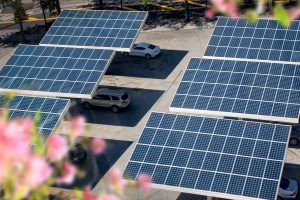4. Energy storage and solar PV
Explore smart EV charging using energy storage and solar PV. Discover Dundee’s innovative hub with solar canopies and adaptable technology.
If your charging requirements exceed the capacity of the local network infrastructure, an alternative to a costly distribution network upgrade is to install a charge point solution which incorporates energy storage.
Energy storage, such as batteries, allows you to store electricity when it is greener and cheaper. This stored, cheap electricity can then be used to charge your electric vehicles (EVs) at times when the national grid is more expensive.
You can generate more renewable energy during daylight hours by installing solar PV. Solar energy can be stored on site and used to charge your vehicles at any time of day at a lower cost. You can also include load management systems integrated with smart charging, and vehicle to-grid (V2G) technology to maximise the usage of your solar PV.
Energy storage does have a capacity limit. Once the stored energy is used, you will have to rely entirely on the existing site connection capacity.
When considering installing energy storage, you must carefully plan what storage capacity you need to achieve the maximum benefits at your site(s). This will depend on the size of your existing electrical connection, anticipated charging demand at the site, and on the load management system.
While it can be expensive, a well-designed energy storage solution may prevent the need for electrical supply upgrades and standing capacity charges. This will make energy storage more cost-effective in the long run.

Case Study – Dundee, Princes Street (Drive Dundee Electric, 2021)
The charging hub opened in 2018 and is the UK’s first electric vehicle charging infrastructure project to include solar canopies and energy storage.
The hub has six 50kW charge points and three 22kW charge points. All are double outlets, so 18 EVs can charge simultaneously.
The solar PV provides up to its rated capacity of 36kW to the energy storage system. The battery can store 90kWh of renewable energy. This is prioritised for the EVs plugged into the chargers before distribution to the national grid.
This solution is future-proofed: larger batteries and more powerful chargers can be installed as the technology develops.

Source: drivedundeeelectric.co.uk